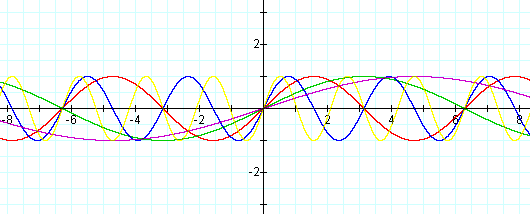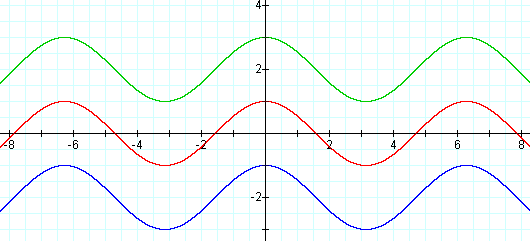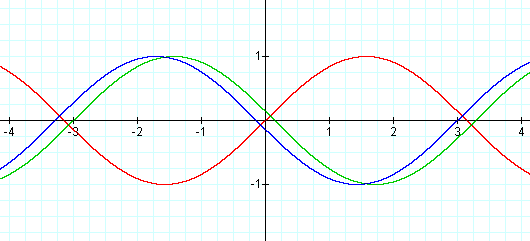
DAY 5 - More Sine and Cosine Graphs - Mary H. Bruce - EMAT 6690
Objective: Students will be able to graph trig functions of the form y = a cos bx, y = a sin bx, y = a cos bx + c, y = a sin bx + c, y = a cos (bx + d) + c
Continuing discussion from day 4, suppose we place the coefficient in front of the argument x. How would the graph of y = sin 1/2 x change from the parent graph y = sin x? Would the amplitude be affected? From day 4 discussion, one should realize the amplitude will still be 1. The argument is now multiplied by 1/2 which will take the graph twice as long to complete one revolution thus affecting the period, or length of a full cycle. Suppose the equation is y = sin 2x. Compare the graphs of y = sin x, y = sin 1/2 x, y = sin 2x, y = sin 1/3 x, y = sin 3x. See if you can discover a mathematical relationship between the "b" in the formula y = sin bx and the period.

It appears that the period = 2Π/b.
Suppose we add or subtract a constant to the function. Many of the concepts in trig graphs should be connected to graphing shifts learned in algebra II ( for example f(x) and f(x) + c). One would guess that we would witness a vertical translation in the same direction as the constant itself.
The graphs of y = cos x, y = cos x + 2, y = cos x -2 follow:

Finally consider the transformation by adding or subtracting a constant inside the function (tie in to f(x) and f(x + c)). One would guess a horizontal translation of x + c = 0. Consider the graphs y = sin x, y = sin(x + 3), y = sin(x - 3):

In trigonometry, we call these horizontal shifts phase shifts.
Students should experiment with the technology and combine several types of transformations within one function to detect the changes in the parent graph.
Exercises: Graph the following:
y = sin 1/4 x
y = cos (x - Π/4)
y = sin (x + Π/2) + 3
y = 2 cos 4(x - Π) - 2
RETURN to Instructional Unit Outline